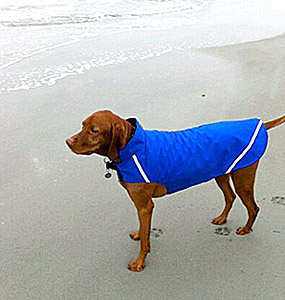Overview
Hypothermia occurs when body temperature falls below normal. A normal temperature for a dog or cat is 100.5 to 102.5 degrees Fahrenheit. Hypothermia can be mild, moderate, or severe depending on how low the body temperature is. The most common cause of hypothermia is prolonged exposure to cold temperatures. Pets can also develop frostbite due to extreme cold. Illness and disease can also cause the body not to be able to regulate its temperature, which can also lead to hypothermia.
 Risk/Symptoms
Risk/Symptoms
Pets that are exposed to extreme cold are at a greater risk of developing hypothermia. Newborn puppies and kittens cannot regulate their body temperature; therefore, they can develop hypothermia even when the environmental temperature is normal. Elderly and sick pets are more susceptible to cold conditions as well. Hypothyroidism as well as disease of the hypothalamus (the portion of the brain responsible for regulating body temperature) can put your pet at a greater risk.
The symptoms of hyperthermia often vary depending on its severity, but you may notice the following:
- Depression
- Lethargy
- Weakness
- Shivering
- Low heart rate
- Difficulty breathing
- Fixed and dilated pupils
- Coma
Diagnosis
Your veterinarian will take your pet’s temperature to determine the severity of the hypothermia. Additionally, your veterinarian may recommend additional testing to determine the underlying cause of the hypothermia.
These may include:
- Chemistry tests to evaluate kidney, liver, and pancreatic disease and dysfunction, as well as sugar levels
- A complete blood count to evaluate if your pet has an infection, inflammation, anemia, or other blood-related condition
- Electrolyte tests to ensure your cat isn’t dehydrated or suffering from an electrolyte imbalance
- Urine tests to screen for urinary tract infection and other disease, and to evaluate the ability of the kidneys to concentrate urine
- A thyroid test to determine if the thyroid gland is producing too little (in dogs) or too much (in cats) thyroid hormone
- An ECG to screen for an abnormal heart rhythm, which may indicate underlying heart disease
Treatment
Treatment for hypothermia depends on its severity but may include:
- Applying blankets to prevent further heat loss
- Applying heating pads or warming blankets (To prevent burns, there should always be a protective layer between these items and the pet’s skin.)
- In severe cases, warm-water enemas or warm fluids (intravenously injected)
Treatment will continue until the pet’s body temperature reaches the normal range.
Prevention
The best way to prevent hypothermia is to not expose your pet to freezing temperatures for an extended amount of time. For sick, elderly, and newborn dogs and cats, keep them warm and away from drafts. This video, "Protect Your Pet From the Cold," explains simple precautions to take and what dangers to watch for in case your pets have extended periods outside during cold weather.
If you have any questions or concerns, you should always visit or call your veterinarian – they are your best resource to ensure the health and well-being of your pets.
